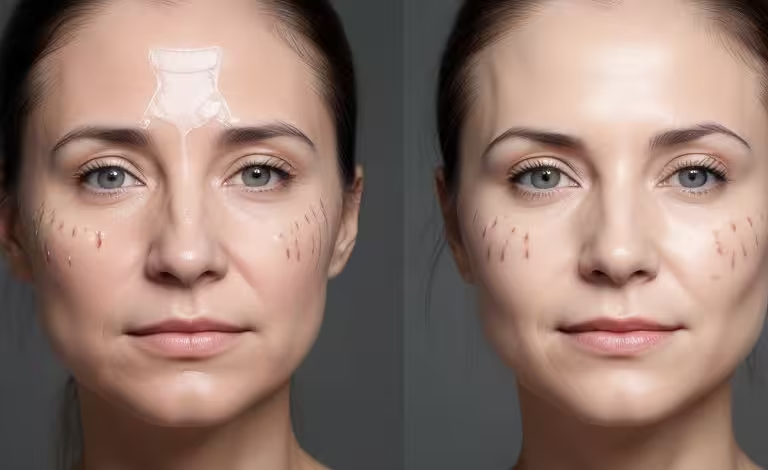
Scars on the Face: Causes, Treatments, and Prevention Tips
Facial scars can be a source of self-consciousness for many people, affecting both appearance and confidence. Whether from acne, injuries, surgery, or other causes, scars on the face can be stubborn and difficult to treat. Fortunately, there are numerous options available to reduce their appearance and even prevent them from forming in the first place. This article will explore the different types of facial scars, their causes, effective treatments, and tips for prevention.
Understanding Facial Scars
Scars form as part of the natural healing process after the skin has been damaged. When the skin is injured, the body produces collagen to repair the damage, which can result in a scar. The appearance of a scar can vary depending on factors like the depth of the injury, skin type, and the individual's healing process.

Types of Facial Scars
There are several types of scars that can develop on the face, each with distinct characteristics:
- Atrophic Scars: These scars are sunken or pitted and often result from acne or chickenpox. They occur when the skin doesn't produce enough collagen during the healing process, leading to a depression in the skin.
- Hypertrophic Scars: These scars are raised and may be red or darker than the surrounding skin. They occur when the body produces too much collagen, causing the scar tissue to rise above the surface of the skin.
- Keloid Scars: Keloid scars are similar to hypertrophic scars but can grow larger than the original wound. They are thick, raised, and often extend beyond the boundaries of the initial injury.
- Contracture Scars: These scars occur when the skin tightens or contracts during healing, which is common after burns. Contracture scars can affect movement if they develop near joints.
- Ice Pick Scars: A type of atrophic scar, these are narrow, deep scars that resemble small holes or punctures in the skin. They are often caused by severe acne.
Common Causes of Facial Scars
Understanding the causes of facial scars can help in both treatment and prevention. Some common causes include:
- Acne: One of the most common causes of facial scars, severe acne can lead to atrophic, ice pick, and hypertrophic scars.
- Injuries: Cuts, scrapes, and other facial injuries can result in scars, especially if the wound is deep or not properly treated.
- Surgery: Surgical procedures on the face can leave scars, particularly if the incision is large or healing is complicated.
- Burns: Burns can cause contracture scars, which may lead to tightness and reduced movement.
- Infections: Infections that damage the skin can also result in scarring, particularly if they cause significant inflammation or tissue loss.
Effective Treatments for Facial Scars
Treating facial scars requires a personalized approach, as the effectiveness of treatment can vary depending on the type and severity of the scar. Here are some of the most common and effective treatments for reducing the appearance of scars on the face:
1. Topical Treatments
Topical treatments are often the first line of defense against facial scars. These include:
- Silicone Gel Sheets: Silicone sheets can help flatten and fade raised scars like hypertrophic and keloid scars.
- Over-the-Counter Creams: Products containing ingredients like vitamin E, retinoids, or onion extract (like Mederma) can help reduce the appearance of scars.
- Prescription Creams: For more severe scars, a dermatologist may prescribe stronger creams containing corticosteroids or other active ingredients.
2. Laser Therapy
Laser therapy is a popular option for treating various types of scars, including acne scars and surgical scars. Different types of lasers can be used to resurface the skin, reduce redness, and stimulate collagen production.
- Fractional Laser Resurfacing: This treatment targets deep layers of the skin and is effective for atrophic scars.
- Pulsed Dye Laser (PDL): PDL is used to reduce redness and flatten raised scars like hypertrophic and keloid scars.
3. Chemical Peels
Chemical peels involve applying a chemical solution to the skin, which causes the top layer to peel off, revealing smoother skin underneath. This treatment can be effective for mild acne scars and hyperpigmentation.
- Light Peels: Often used for mild scars, light peels involve a gentle acid like glycolic acid.
- Medium Peels: These peels penetrate deeper into the skin and can treat more pronounced scars.
- Deep Peels: Deep peels are more intense and are used for severe scarring, but they require a longer recovery time.
4. Microneedling
Microneedling involves using a device with fine needles to create tiny punctures in the skin. This process stimulates collagen production and can improve the texture and appearance of scars.
- Radiofrequency Microneedling: This advanced form of microneedling combines traditional microneedling with radiofrequency energy to enhance results, especially for deep scars.
5. Dermal Fillers
For atrophic scars that cause depressions in the skin, dermal fillers can be used to plump up the area and create a smoother surface. The effects are temporary, lasting several months to a year, depending on the filler used.
6. Surgical Procedures
In some cases, surgery may be necessary to remove or reduce the appearance of facial scars. Surgical options include:
- Scar Revision Surgery: This procedure involves removing the scar tissue and repositioning the surrounding skin to create a less noticeable scar.
- Punch Excision: Often used for ice pick scars, punch excision involves removing the scar with a small surgical tool and then stitching the skin together.
- Subcision: This technique involves using a needle to break up the scar tissue under the skin, allowing it to rise and create a smoother appearance.
7. Steroid Injections
Steroid injections can be used to flatten and soften raised scars, such as hypertrophic and keloid scars. This treatment can be combined with other therapies for better results.
Preventing Scars on the Face
Prevention is always better than cure, and there are several steps you can take to minimize the risk of developing scars on your face:
1. Treat Acne Early
If you suffer from acne, it's important to treat it early to prevent scarring. Use over-the-counter treatments like benzoyl peroxide or salicylic acid, and consider seeing a dermatologist for prescription options if your acne is severe.
2. Avoid Picking at Your Skin
Picking at pimples, scabs, or other skin imperfections can lead to scarring. It's important to avoid touching or squeezing spots on your face to allow them to heal naturally.
3. Use Sunscreen
Sun exposure can darken scars and make them more noticeable. Always apply sunscreen with at least SPF 30 to protect your skin and prevent scars from becoming more pronounced.
4. Proper Wound Care
If you sustain an injury to your face, proper wound care is crucial to minimize scarring. Clean the wound with mild soap and water, apply an antibiotic ointment, and cover it with a sterile bandage. Keep the area moist and avoid picking at the scab.
5. Stay Hydrated and Eat a Balanced Diet
Staying hydrated and eating a diet rich in vitamins and minerals can promote healthy skin and aid in the healing process. Foods high in vitamin C, zinc, and protein are particularly beneficial for skin repair.
Final Thoughts
Facial scars can be distressing, but with the right treatment and care, their appearance can be significantly reduced. From topical treatments to advanced medical procedures, there are options available to suit every type of scar. Additionally, by taking steps to prevent scarring in the first place, you can keep your skin looking smooth and healthy. If you're concerned about facial scars, it's always a good idea to consult with a dermatologist who can recommend the best course of treatment for your specific needs.

